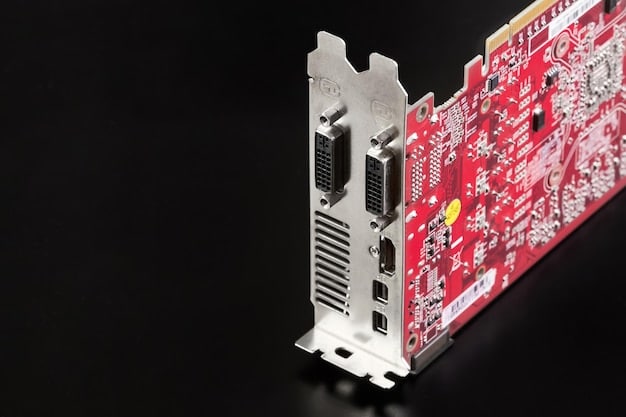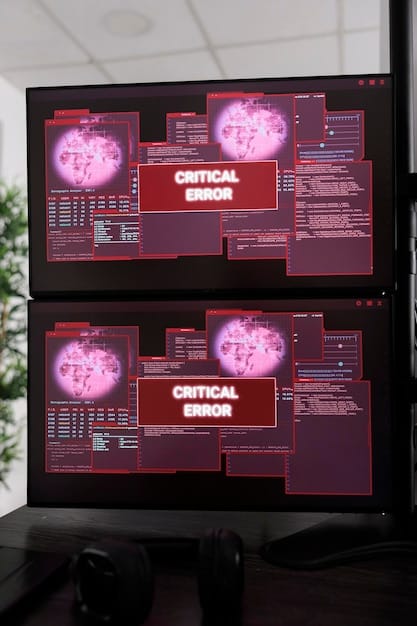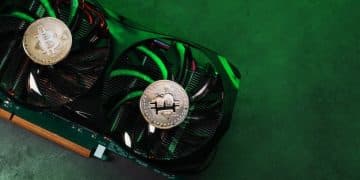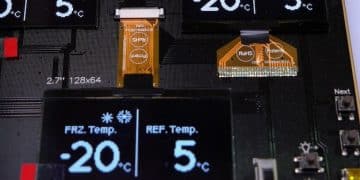Optimize AMD GPU Drivers: A Guide for the Next 3 Months

To optimize AMD GPU performance for the latest games in the next three months, regularly update drivers, tweak in-game settings, and monitor hardware performance to ensure a smooth and immersive gaming experience.
Ensuring your AMD GPU is ready for the latest game releases requires more than just having the hardware. It’s about staying on top of AMD GPU Driver Updates: How to Optimize Your Settings for the Latest Game Releases in the Next 3 Months to unlock peak performance and a smoother gaming experience.
Understanding AMD GPU Drivers
AMD GPU drivers are software packages that enable communication between your graphics card and your operating system, ensuring compatibility and optimal performance. Regular updates are essential for leveraging the latest enhancements and bug fixes.
These updates often include performance improvements specifically tailored for newly released games, addressing issues, and unlocking new features.
Why Driver Updates Matter
Driver updates are crucial for several reasons, primarily because they enhance stability, improve performance, and introduce support for new games. Without the latest drivers, gamers may encounter visual glitches, crashes, or suboptimal frame rates.”
How to Check Your Current Driver Version
Before installing any new drivers, it’s helpful to know what version you’re currently running. This information can be found within the AMD Adrenalin software.
- Open the AMD Adrenalin software.
- Click on the “Settings” icon (usually a gear).
- Go to the “System” tab.
- Look for the “Software” section to find your driver version.
Keeping track of your current driver version allows you to easily identify if an update is necessary and ensures you are always on the most current and best optimized driver for your AMD GPU.
In conclusion, understanding the significance of AMD GPU drivers and keeping them updated is essential for maintaining optimal graphics card performance and ensuring a smooth gaming experience. Regular driver updates often incorporate performance improvements and stability enhancements, specifically tailored to recent game releases, providing gamers with the best possible gaming experience.

Installing the Latest AMD GPU Drivers
Keeping your AMD GPU drivers up to date is a straightforward process, thanks to the AMD Adrenalin software. Whether you choose to update manually or automatically, you can ensure your graphics card is always running at its best.
Here’s a breakdown of how to install the latest AMD GPU drivers, covering both automatic and manual methods. It’s always a good idea to back up your system before software updates.
Automatic Updates
The easiest way to keep your drivers updated is to enable automatic updates within the AMD Adrenalin software. This way, the software will automatically check for new drivers and prompt you to install them.
To enable automatic updates, follow these steps:
- Open the AMD Adrenalin software.
- Go to the “Settings” menu.
- Select the “Update” tab.
- Enable “Automatically Check for Updates.”
Manual Installation
If you prefer to have more control over when and what drivers are installed, you can opt for manual installation. This involves downloading the latest drivers from the AMD website and installing them yourself.
To manually install the drivers:
- Go to the AMD Support website.
- Select your graphics card model.
- Download the latest driver version.
- Run the downloaded installer and follow the on-screen instructions.
In summary, updating your AMD GPU drivers is a simple but essential task for maintaining optimal graphical performance. By using either automatic updates or the manual installation method, you can ensure that your graphics card is always running at its peak, providing a seamless and immersive gaming experience, particularly with the latest game releases.
Optimizing AMD Adrenalin Settings for Gaming
The AMD Adrenalin software offers a plethora of settings to customize your gaming experience. Optimizing these settings can significantly enhance performance, visual quality, and responsiveness.
Here’s a closer look at some key settings and how to tweak them for the best possible gaming experience. By adjusting the AMD adrenaline settings, you can enhance your gaming experience by prioritizing either visual quality or performance.
Radeon Anti-Lag
Radeon Anti-Lag reduces input lag, making your actions feel more responsive. Enabling this feature can be particularly beneficial in fast-paced games where reaction time is critical.
Radeon Boost
Radeon Boost dynamically lowers the rendering resolution during fast motion, improving frame rates without significantly impacting visual quality. It’s an excellent option for maintaining high frame rates in demanding games.
- Experiment with different Radeon Boost settings to find a balance between performance and image quality.
- Consider using Integer Scaling for a sharper image when lowering the resolution.
Image Sharpening
AMD’s Image Sharpening feature enhances the clarity of textures and details, making games look sharper and more visually appealing. Adjusting the sharpening level allows you to find the perfect balance for your display and personal preferences.
In conclusion, taking the time to optimize your AMD Adrenalin settings is essential for elevating your gaming experience. By tweaking settings such as Radeon Anti-Lag, Radeon Boost, and Image Sharpening, you can strike the ideal balance between performance, visual quality, and responsiveness. Tailoring these settings to your specific games and hardware can lead to smoother and more visually stunning gameplay.

Understanding Game-Specific Optimization
While global settings can provide a baseline improvement, optimizing settings on a per-game basis ensures the best possible experience. Each game has unique demands and can benefit from specific tweaks to graphics settings.
This section explores the importance of game-specific optimization and how to identify and adjust key settings for individual titles. Also, check community forums and guides to learn what settings are optimal for other players.
Analyzing In-Game Settings
Most games offer a range of graphics settings that can be adjusted to balance visual quality and performance. Understanding these settings and their impact on your GPU is crucial for optimization. Key settings include:
- Texture Quality: Affects the detail and clarity of textures. Higher settings require more VRAM.
- Shadow Quality: Impacts the realism and detail of shadows. Lowering this can significantly improve performance.
- Anti-Aliasing: Reduces jagged edges. Different methods (like MSAA, FXAA, and TAA) have varying performance costs.
Utilizing AMD’s Radeon Software Overlay
AMD’s Radeon Software Overlay allows you to monitor your GPU’s performance in real-time while you play. This tool can help you identify bottlenecks and adjust settings accordingly.
In summary, achieving the best gaming experience with your AMD GPU requires more than just applying global settings. Optimizing graphics settings on a per-game basis is essential, allowing you to tailor your setup to the unique demands of each title. Analyzing in-game settings and utilizing tools like the AMD Radeon Software Overlay helps to strike the perfect balance between visual quality and performance, ensuring smooth and immersive gameplay.
Monitoring Hardware Performance
Monitoring your hardware performance is essential for identifying potential bottlenecks and ensuring your system is running optimally. Tools like AMD Adrenalin and other monitoring software provide valuable insights into GPU and CPU usage, temperatures, and frame rates.
This section covers the best tools for monitoring your hardware and how to interpret the data to make informed decisions about your settings.
Key Metrics to Monitor
When monitoring your hardware, there are several key metrics to keep an eye on. These metrics provide insights into your GPU’s performance and can help you identify performance bottlenecks:
- GPU Usage: Indicates how much of your GPU is being utilized. High usage is generally good, as it means your GPU is working hard.
- GPU Temperature: Shows the temperature of your GPU. High temperatures (above 80°C) can indicate cooling issues.
- Frame Rate (FPS): Measures how many frames per second your GPU is rendering. Higher FPS results in smoother gameplay.
Using AMD Adrenalin for Monitoring
AMD Adrenalin includes a built-in performance monitoring tool that allows you to track key metrics in real-time. To access the performance overlay:
- Open the AMD Adrenalin software.
- Go to the “Performance” tab.
- Enable “Show Metrics Overlay.”
In conclusion, monitoring your AMD GPU’s performance is an essential part of optimizing your gaming experience. By using tools like AMD Adrenalin and understanding key metrics such as GPU usage, temperature, and frame rate, you can identify bottlenecks and make informed decisions about your settings. Regularly monitoring your hardware ensures that your system is running optimally and helps prevent potential issues.
Troubleshooting Common Issues
Even with the latest drivers and optimized settings, you may occasionally encounter issues with your AMD GPU. Troubleshooting these problems effectively can save you time and frustration.
This section covers common problems that may arise and provides practical solutions to resolve them, ensuring a smooth gaming experience.
Driver Conflicts
Driver conflicts can occur when multiple drivers interfere with each other, leading to crashes or performance issues. To resolve driver conflicts:
- Use a Display Driver Uninstaller (DDU) to completely remove old drivers.
- Reinstall the latest AMD drivers.
- Avoid installing beta drivers unless you are comfortable with potential instability.
Overheating
Overheating can cause performance throttling and even damage your GPU. To prevent overheating:
- Ensure your GPU cooler is properly installed and functioning.
- Clean dust from the fans and heatsink.
- Consider improving your case’s airflow by adding more fans.
Game-Specific Problems
Some issues may be specific to certain games. These can often be resolved by:
- Checking the game’s official forums for known issues and solutions.
- Verifying the game’s files through the platform (Steam, Origin, etc.).
- Adjusting graphics settings within the game to reduce the load on your GPU.
In summary, even with the most up-to-date drivers and finely tuned settings, issues can arise with your AMD GPU. Proactive troubleshooting is essential for maintaining a smooth and enjoyable gaming experience. By addressing common problems such as driver conflicts, overheating, and game-specific issues, you can keep your system running optimally and prevent potential frustration.
Future Trends in AMD GPU Technology
As technology continues to advance, AMD is at the forefront of innovation in GPU technology. Staying informed about upcoming trends will help you prepare for future advancements and make informed decisions about your hardware upgrades.
This section explores some of the future trends in AMD GPU technology, including new architectures, features, and software enhancements.
Next-Generation Architectures
AMD is constantly developing new GPU architectures to improve performance, efficiency, and features. Future architectures are expected to focus on:
- Increased Ray Tracing Performance: Enhancements to ray tracing technology for more realistic lighting and reflections.
- AI and Machine Learning Integration: Integrating AI and machine learning capabilities directly into the GPU for improved performance.
- Improved Power Efficiency: Reducing power consumption while maintaining or improving performance.
Software Enhancements
AMD is also investing in software enhancements to complement its hardware innovations. Key areas of focus include:
- Advanced Driver Optimization: Continuously improving driver performance and stability through regular updates.
- Radeon Super Resolution (RSR) Improvements: Enhancing the quality and performance of RSR technology.
- Integration with New APIs: Ensuring compatibility and optimal performance with new gaming APIs like DirectX 13 and Vulkan.
In summary, AMD is dedicated to continuous innovation in GPU technology, paving the way for future advancements in gaming and graphics performance. Keeping informed about emerging trends, such as next-generation architectures and software enhancements, will help you prepare. By staying ahead of these developments, you can make confident decisions about your hardware and software choices, ensuring a seamless and immersive gaming experience for years to come.
| Key Point | Brief Description |
|---|---|
| 🔄 Update Drivers | Keep your AMD GPU drivers updated for performance improvements and bug fixes. |
| ⚙️ Optimize Settings | Adjust AMD Adrenalin settings like Anti-Lag and Boost for better gaming. |
| 📊 Monitor Performance | Track GPU usage, temperature, and FPS to identify bottlenecks. |
| 🎮 Game-Specific Tweaks | Optimize graphics settings for individual games for best results. |
FAQ
▼
It is generally recommended to update your AMD GPU drivers whenever a new driver is released, especially if it includes optimizations or fixes for games you play. Check the AMD Adrenalin software regularly.
▼
AMD Adrenalin is a software suite that allows you to manage and optimize your AMD GPU. You can use it to update drivers, monitor performance, and customize graphics settings for games. It’s your control panel for your GPU.
▼
You can monitor your GPU temperature using the AMD Adrenalin software’s performance overlay. Enable the overlay to see real-time temperature readings while you game. High temperatures may indicate cooling issues.
▼
If you encounter a driver conflict, use a Display Driver Uninstaller (DDU) to completely remove the old drivers. After that, reinstall the latest AMD drivers for a clean installation without any interferences.
▼
Beta drivers can offer new features and performance improvements, but they may also be less stable than official releases. Use them at your own risk, and be prepared to revert to a stable driver if issues arise.
Conclusion
Optimizing your AMD GPU for the latest game releases involves staying updated with the latest drivers, tweaking settings in the AMD Adrenalin software, and monitoring hardware performance. By following these steps, you can ensure a smooth, immersive, and visually impressive gaming experience for the next three months and beyond.





